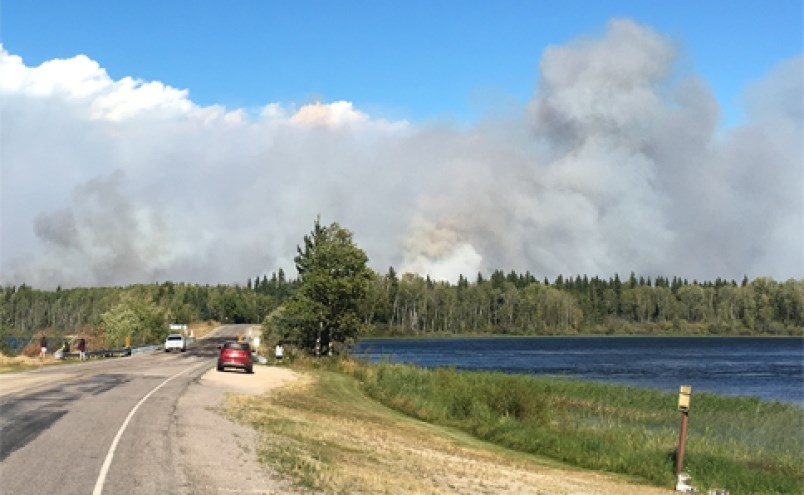A report from the Univ. of Saskatchewan has levelled accusations of mismanagement, cultural insensitivity and hardship during the evacuation of Pelican Narrows and nearby communities in 2017.
The report was compiled by researchers with the U of S, residents of Pelican Narrows and high-ranking members of the Peter Ballantyne Cree Nation (PBCN) and other northern bands. The report details the evacuation of Pelican Narrows and other northern communities due to forest fires in 2017. Pelican Narrows residents, along with others from Sandy Bay, Jan Lake, Birch Portage and elsewhere, were moved throughout Saskatchewan during the fires. People considered to be especially vulnerable - including Elders, children and pregnant women - were moved first.
Many decisions involving the move were handled with little to no consultation with people living in the north, according to the report.
“It was found that application of provincial models of evacuation and reliance on top-down, often inflexible, centralized approaches stunted the community’s ability to make decisions in its best interests and failed to meet their specific needs,” reads the report.
Areas of concern noted in the report are risks posed to locals during the evacuation, vulnerability and resilience. Incidents of open racism toward Indigenous evacuees were also mentioned.
“Many residents experienced unfortunate incidents which they interpret as racist. This includes experiences with hotels, non-governmental aid organizations and the news media,” said the report.
“It remains clear that despite the annual nature of evacuations there continues to be ignorance of and lack of empathy for the situation in which evacuees find themselves. Service providers expect evacuees to conform to their expectations regarding behaviour and to be appreciative of aid provided and are freely critical when these expectations are not met.”
One main concern brought up in the report is the Saskatchewan government’s policy on fighting northern forest fires - namely, to let fires in isolated northern areas burn if they are not near inhabited communities and a perceived lack of consultation between provincial forces and local governance.
“Issues of jurisdiction and communication also emerge again in this research. The residents feel that there was an unnecessary delay in fighting the fire and calling for the evacuation, and point to non-Indigenous communities receiving preferential treatment,” the report reads.
“There remains widespread concern about the ‘Let it Burn’ policy of the government, which is locally interpreted as a means to prioritize southern ‘white’ values over northern Indigenous ones. The government’s continued denial of this policy falls on deaf ears when local people are not involved in the decision-making and when communication falters. Concerns over who would pay for the costs of the evacuation should the First Nation declare an emergency on its own clouded the ability of local leadership to act in the community’s best interests.”
The report makes 12 recommendations, including calls for people from soon-to-be affected communities to be more involved with evacuation, using culturally sensitive policies and procedures when moving people out, taking specialized care for vulnerable people, reclassifying how risk is assessed, considering input from Elders and using out-of-town family members to rehouse people if possible.
Other recommendations include using evacuations to southern cities as a last resort and allowing northerners to have more of a say in how evacuation centres and shelters are run and maintained, along with having counselling available to people who may need it post-catastrophe.
“An acknowledgement of the ongoing and historical relationships between Indigenous peoples and the state and its agencies is central to cultural safety,” reads the report.
“This means a clear understanding of how making decisions on their behalf and appearing to order northern Indigenous people on to buses and taking them to unknown destinations may invoke parallels with, and traumatic memories of, residential schools and the Sixties Scoop.”
The role of the media in covering the fires was also criticized in the report, with some articles cited bringing up incidents of mischief, drunkenness or other issues with a small number of evacuees.
“Some felt that the reporters who documented the evacuation exaggerated their behaviours and made them look like they are not doing a good job of policing their own people. Said one, ‘Well that’s the thing I don’t appreciate myself, this sensationalism... They don’t really understand the situation.’”
A recollection from a teacher from Pelican Narrows interviewed in the report said reporters would camp outside a shelter where people stayed, waiting for people to walk outside.
“She told the residents that they did not have to talk to reporters and they could simply walk away. The types of questions asked also angered her. ‘They were more for the ‘aren’t you devastated, your home is going to go up in flames’ kind of thing, trying to get a reaction from people,’” reads the teacher’s recollection.
“‘They would camp outside the fieldhouse waiting for people to come out. I’d say [to the people], ‘don’t go out there’ and then I started telling everybody, ‘you don’t have to say anything to them if you don’t want to.’ The reporters focused on the negative aspects of the evacuation, and in the process, they represented Pelican in a poor light.”
One recommendation speaks to “a need for insightful and empathetic reporting of the situation of evacuees by the news media.”
“Regular briefings of media by community officials during evacuations would be valuable. Media must be reminded to be respectful of evacuees and make better efforts to understand their situation. To this end, they should be encouraged to seek information only from official channels rather than the evacuees themselves who are unlikely to have experience with the media.”
The Reminder did not attempt to reach out to people who had been evacuated from the community during the fire, contacting a small number of people only once they had returned home safely.




